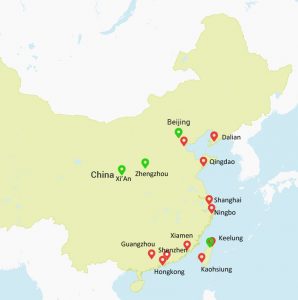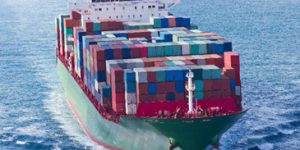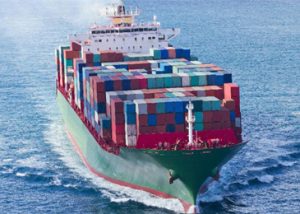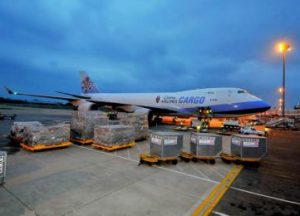Sea Freight Shipping From China: A Complete Guide
Sea freight shipping is the main shipping method for global export & import business. Low prices, large volumes, FCL or LCL options, all these advantages it as the first choice for international trade.
In this article, you’ll learn:
- The Process of International Logistics
- The most common incoterms used in sea freight shipping
- How to calculate the volume of full container load
- The most import documents you need to know when shipping from China
- Top shipping ports in China
The Big Players Involved In International Logistics
1.Shipping Company
This refers to a company that handles the shipment of goods. The service of shipping companies is usually employed due to the following reasons:
Convenience
Shipping companies helps to make shipping convenient. They know the best way to package and ship goods. They also help you saving time, energy and money on packaging supplies.
Better ShoppingExperience
Shipping companies help to create a better shopping experience without any disappointment through the creation of an accessible shipping location.
Ability to Send Packages Anywhere
Shipping companies help you to send packages all over the world. Some shipping companies enable you to buy your items, have them shipped to your mailing address and then forward them to you.
2.Custom Broker
Custom brokers prepare and submit documentation to notify or obtain clearance for you. They also arrange local delivery of items through trucking companies. Custom brokers can be located at inland ports so that they can clear merchandise sent “in bond.” Most custom brokers are located at major airports and harbors that have international traffic.
The customs brokers in the USA:
https://apps.cbp.gov/brokers/index.asp?portCode=2704
The licensed customs brokers in Canada:
http://www.cbsa-asfc.gc.ca/services/cb-cd/cb-cd-eng.html
For importers in Europe and other countries, check out the International Federation of Customs Brokers Association (IFCBA) on:
http://ifcba.org/List_of_Members
3.Freight Forwarder
A freight forwarder (also known as non-vessel operating common carrier) refers to a person or company that organizes shipments for individuals or companies to move goods from the manufacturer to the destination.
Freight forwarder can be better to work with than customs brokers depending on your product, how frequent you are shipping goods, and the shipping way that you choose.They handle inter-country movement of cargo by acting as the middlemen between the shipping lines and the importer or exporter. They are hired to get the product to the customer by a particular date in an undamaged state. Their tasks such as:
- Packaging
- Labeling
- Documentation
Shipping from China 101: The Process of International Logistics
International logistics involves planning and managing the flow of goods in a company’s supply chain from acquisition to customer purchase. Part of the process involves crossing at least an international border.
The figure below shows the diagrammatic representation of the whole process:
All You Need To Know About Incoterms
Shipping incoterms refer to international standard codes that determine when and where a cargo will be transferred between the supplier and the importer. They are trade terms that are being published by the International Chamber of Commerce (ICC). These terms are usually used in international and domestic trade contracts.
The commonest trade terms include:
- FOB Shipping (Free on Board Shipping)
FOB means Free On Board. It indicates when liability and ownership is transferred from a seller to a buyer. When customers use FOB shipping, the designation determines the person that will handle the payment of the freight charges and the point the shipment passes from the seller to the buyer.
Buyer and Seller Liability For FOB Shipping
| Seller | Buyer |
| Delivery goods and transfer documents |
Payment and provision of documents. Picks up goods. |
| Handles export customs clearance procedures and payment | Handles import customs clearance and payment |
| Charters booking and pays the sea freight fee | |
| Handles insurance and pays insurance premium | |
| Bears all risks before the goods have crossed the port of loading | Bears all risks and expenses after the goods have crossed the port of shipment |
CFR Shipping (C&F Shipping)
CFR stands for Cost and Freight. It implies that the seller needs to pay the costs and freight that’s needed to bring the goods to a particular port of destination. In this case, the risk of loss or damage of goods as well as the additional costs (after the goods have been delivered on board the vessel) is transferred from the seller to the buyer.
In CFR shipping, the seller needs to arrange for the carriage of goods by sea to a port of destination and also provide the necessary documents (that will be needed to obtain the goods from the carrier) to the buyer.
Buyer and Seller Liability for CFR Shipping
| Seller | Buyer |
| Delivery of goods and transfer of documents |
Payment and provision of documents. Picks up goods. |
| Handles export customs clearance procedures and payment | Handles import customs clearance and payment |
| Charters booking and pays the sea freight fee | |
| Handles insurance and pays insurance premium | |
| Bears all risks before the goods have crossed the port of loading | Bears all risks and expenses after the goods have crossed the port of shipment |
CIF Shipping
CIF (Cost, Insurance and Freight) is a term that requires the seller to arrange for the carriage of goods by sea to a port of destination and also provide the buyer with the documents that are needed to obtain goods from the carrier.
Buyer and Seller’s Liability for CIF Shipping
| Seller | Buyer |
| Delivery of goods and transfer of documents |
Payment and provision of documents. Picks up goods. |
| Handles export customs clearance procedures and payment | Handles import customs clearance and payment |
| Charters booking and pays the sea freight fee | |
| Handles insurance and pays insurance premium | |
| Bears all risks before the goods have crossed the port of loading | Bears all risks and expenses after the goods have crossed the port of shipment |
Shipping Containers
In case you plan to import full container loads, you can use any of the following four different container volume options:
FCL 20’’ (Volume: 33.2 cbm)
Image source: www.yiwugroup.com
It has dimension 5.89m x 2.35m x 2.39m and maximum weight 24 tons. The actual cargo gross weight is 18 tons.
FCL 40’’ (Volume: 67.7 cbm)
It has dimension 12.03m x 2.35m x 2.39m and maximum weight 30.48 tons. The normal cargo gross weight is 26 tons.
FCL 40’’ HQ (Volume: 76.3 cbm)
It has dimension 12.03m x 2.35m x 2.69m and maximum weight 30.48 tons. The actual cargo gross weight is 26 tons.
Different shipping companies may have different container volume. You can save lots of money on sea freight cost that’s related to the container volume. You can do this by placing orders based on the units that align with a particular container size and not a predetermined quantity.
By doing this, you will be able to avoid situations you pay for empty space or ordering one FCL container and one LCL container.
Since LCL attracts higher port charges and ‘per shipment’ administrative fees than FCL shipping, the latter situation is often more costly.
Less Than Container Load (LCL) Shipping
Less than Container Load refers to a shipment that will not fill a container. In LCL shipment, you pay for your load to be shipped in a container with one or more loads from other customers of the freight transport provider. LCL is the most reasonable option to use if you cannot fill a 20-foot container due to the cost and convenience.
There’s no need to worry about returning the container after delivery when you are using LCL shipping. Since you’re sharing the container, the shipping container service company is the one that will worry about the likelihood of having return trips booked for that container. Shippers making use of LCL should only be concerned about the load that is being shipped.
Full Container Load (FCL ) Shipping
This is a type of ocean freight. It does not mean you need to have enough cargo that will fill an entire container. The benefit of FCL shipping is that you don’t need to share a container with other shipments. If you are shipping 6 standard pallets in a 20ft container, 12 standard pallets or more in a 40ft container, the cost effective means of shipping such cargo is by making use of FCL shipment and not LCL shipment.
Practical Example when shipping from China
As stated earlier, the theoretical loading volume for the 3 different containers are:
- FCL 20’’ (Volume: 33.2 cbm)
- FCL 40’’ (Volume: 67.7 cbm)
- FCL 40’’ HQ (Volume: 76.3 cbm)
However, in a real world, it can barely load the same volume. Based on my experience in calculating the loading volumes, here are two tips that I have for you; if the packaging volumes are lower than 0.02m³/ctn, then the actual loading volumes are:
- FCL 20’’ (Volume: 28 cbm)
- FCL 40’’ (Volume: 56 cbm)
- FCL 40’’ HQ (Volume: 68 cbm)
If the packaging volumes are more than 0.04m³/ctn then the actual loading volumes are:
- FCL 20’’ (Volume: 24-25 cbm)
- FCL 40’’ (Volume: 53-54 cbm)
- FCL 40’’ HQ (Volume: 63-65 cbm)
Note that the accurate loading volumes could be slightly different depending on your situation.
I once had a customer that wanted to buy quadcopter drone toys in 40 feet container and shipping from china to us. The outer packaging had dimension 670mm x 570mm x 505mm with 6 boxes.
In this case, the calculation was carried out as follows:
I added 5mm more for each side. That gives: 0.675m x 0.575m x 0.51m ≈ 0.198m³
Depending on the situation of the packaging, if it has swelled, we can add 1cm-2cm.
0.198m³/ctn > 0.04m³/ctn so we choose these number for 40 feet container
54/0.198 = 272 boxes
In total, we have 272 x 6 = 1636 unit drones
We can slightly load 10-20 more boxes in this case. However, 272 is 100% safe.
Packaging For Sea Freight Shipping
When selecting your packing materials, it is important to carefully examine the types of packages that are available. You need to take note of import restrictions such as quarantine requirements of the destination countries.
When you are packaging a product for export purpose, you need to consider factors such as:
- Breakage
- Weight
- Moisture, and
- Pilferage
How a product is packaged depends on the destination and the means of transportation. Your package needs to be designed in such a way that it can handle stress and repeated loading and unloading. When packaging for air shipments, lighter packaging materials must be used. Plain boxes without logos or brand names must be used to avoid theft.
Shipping From China Cost
When shipping goods to USA/Canada/Europe/Australia through oceanic routes, lots of factors should be considered to ensure a successful freight. The following factors determine the cost of shipment:
- Size and Wight
Size and weight determine, to a very large extent, the cost of your shipment. The distance covered and the commodity also influences the shipping rates. Thus, you need to consider the accurate measurements and weight of your cargo. You also need to identify the commodity that you are shipping.
- Freight Class
Freight class also impacts your shipping cost. A detailed explanation of what freight classification entails can be provided by your freight specialist. Basic freight classification guidelines to LTL shipping involve:
- The weight
- Type of packing
- Value of the shipment
- Susceptibility of products to damage
- Product’s load-ability, and
- Handling characteristics.
The freight classification increases with the fragility and value of your products.
- Dimensional Weight
Dimensional weight is an important factor that influences shipping cost but can be confusing. Dimensional weight is a standard formula employed by freight shipping companies and considers the density of a shipment when determining shipping costs. Apart from gross weight, dimensional weight also determines the transportation fees.
Important Documents Used In Sea Freight Shipping
- Bill of Lading
Bill of Lading (B/L) refers to the ticket that outlines the journey of the cargo from its origin to its destination. It’s synonymous to an airline issuing a ticket to a passenger. The bill of lading is issued by a carrier to a shipper and outlines the method and path of a shipment (irrespective of the path). It acts as a contract for the shipment of goods with the terms of the contract outlined on the back of the bill. It also functions as the receipt for the cargo and as a proof of ownership of the goods being shipped.
Bill of lading outlines the key players in the shipment of your goods. The players include:
- The shipper and consignee of the goods
- The carrier that issued the Bill of Lading
- The origin freight forwarder
- The arrival agent/ destination freight forwarder
- The freight payer (this indicates the person that is paying for the transportation)
Also, the Bill of Lading shows the goods that are being shipped as well as the specific handling instructions. The information often include:
- The content of the shipment (such as hanging garments, electronics, food)
- The type of inner packaging (for instance boxes, crates, drums, sacks or rolls)
- The type of outer packaging
- Identifying markings or characteristics
- Type of transportation used
- Specific handling instructions
- Weight and volume of the cargo
Moreover, the Bill of Lading also maps out journey that the shipment will go through to get from the seller to the buyer. The details mapped out include:
- The origination of the shipment
- The destination of the shipment
- The route the shipment will take to move from one place to the other
- The date the shipment is received for transport
- The vessels the shipment is planned to move on
- Commercial Invoice and Packing List
A commercial invoice is a list of contents that seller provides to buyer which includes information such as the product name, specification, quantity, unit price, total amount, etc. It helps foreign buyers to confirm the goods that are paid for. It’s also useful for the custom clearance and for paying duty and tax when the goods arrived. Despite the fact that the commercial invoice is not a receipt (like bill of landing) for the goods, it is one of the most important documents in import/export trading process.
A packing list is a list of the details of the package. The packing list is the supplementary document of the invoice, which details the packing method and packing materials, packing quantity, the specification and the quantity of cargo, the weight and so on. It is used by the importer and the customs to inspect and verify the goods.
The data and content in a Packing list must be consistent with the contents in the bill of lading and other documents as well.
Top Shipping Ports in China

Top Shipping Ports in China
China has more than 2,000 ports, 130 of which are open to foreign ships. China has sixteen “major” shipping ports with a capacity of over 50 million tons per year. Combined China’s total shipping capacity is in excess of 2,890 million tons. By 2020, 40% of the world’s shipping is expected to originate from China. In 2003, China’s major coastal ports handled 2.1 billion tons of freight. As of 2007, China’s merchant fleet had 1,775 ships (1,000 GT or over) 22,219,786 GT/33,819,636 tonnes deadweight (DWT) by type: barge carrier 3, bulk carrier 415, cargo ship 689, carrier 3, chemical tanker 62, combination ore/oil 2, container ship 157, liquefied gas 35, passenger 8, passenger/cargo ship 84, oil tanker 250, refrigerated cargo ship 33, roll-on/roll-off 9, specialized tanker 8, vehicle carrier 17.
The top shipping ports in China include:
1.Port of Shanghai
This includes Yangshan Deep Water Port & Waigaoqiao Shipping Terminals and it’s been operated by Shanghai International Port (Group) Co., Ltd. The port now handles over 35 million Twenty-foot Equivalent Unit containers per year and it keeps growing with more plans on ground to increase its capacity.
2.Port of Shenzhen
It includes Yantian Port, Shekou Port, Dachan Bay Port and Chiwan Port, and it is being operated by Shenzhen Yantian Port Holdings and Shenzhen Chiwan Wharf Holdings. The name ‘Port of Shenzhen’ is a collective term that refers to the multitude of ports found in Shenzhen City.
3.Port of Qingdao
It includes Dagang Port Area and Qianwan Container Terminal. The port is operated by Qingdao Port (Group) Co., Ltd.
4.Port of Ningbo
It includes Zhenhai Port and Beilun Port and it is being operated by Ningbo Zhoushan Port Group Co., Ltd. It is officially called the Port of Ningbo-Zhoushan since Ningbo and Zhuoshan ports were merged in 2006.
5.Port of Guangzhou
The port includes Xinsha Port Area, Nansha Terminal, Downtown Port Area, Huangpu Port Area, and it’s operated by Guangzhou Port Group Co., Ltd.
6.Port of Tianjin
It includes South Port, East Port and North Port, It is operated by Tianjin Port (Group) Co., Ltd. It is located about 150km southeast of Beijing. The port made headlines in 2015 after various explosions (caused by poor chemical storage) led to damages and loss of lives.
7.Port of Xiamen
It includes Haicang Port Area and Dongdu Port Area. It is operated by Xiamen Port Holding Group.
8.Port of Dalian
It includes Dayaowan Port and it’s operated by Dalian Port Group Co., Ltd. The port is located in Liaoning province. It shares a border with North Korea and it’s China’s most northerly ice-free port.
9.Port of Hong Kong
It includes Kwai Tsing Container Terminals and it’s operated by Modern Terminals Limited, Hongkong International Terminals Limited, China Ocean Shipping (Group) Company, DP World, Asia Container Terminals Ltd. In recent years, its volume of shipping trade has fallen behind Singapore, Shanghai and Shenzhen. It remains an important port for trade with South East Asia.
Feedback
-
This is a statement about shipping from China,Please feel free to leave your comments and suggestions too. We will first give you reply that day price and material.










